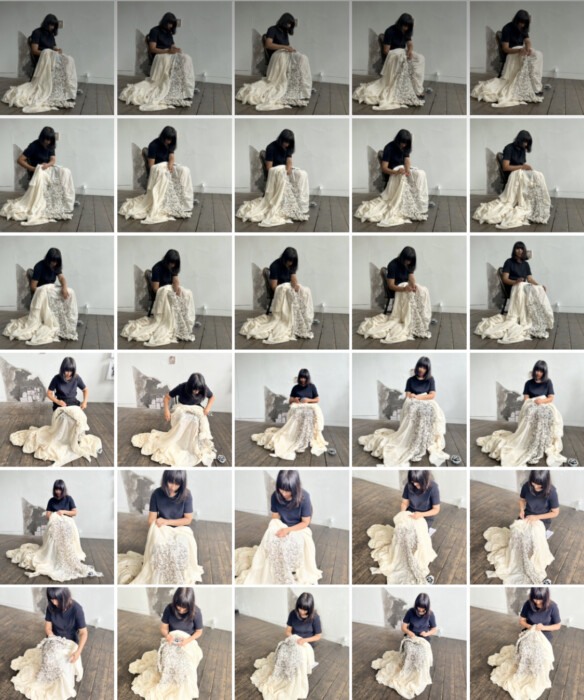Sprigged: A Million Little Cuts
Sohaila Baluch
I have been inserting small pieces of garden twist ties into muslin fabric, combining one quotidian material with another. Each carries its own distinct history and political heritage. The process mirrors the intricate and demanding art of sprigging, requiring focus, precision and skill.
Muslin is a simple woven cotton fabric that originates from Dhaka, Bangladesh, where it was handwoven for many centuries. It is a delicate and light fabric valued for its versatility and durability. Traditionally, sprigging is a delicate form of embroidery that involves a hooked stitching technique made with a tambour hook, a tool like a fine needle with a crochet hook at one end. The practice always requires the continuous use of both hands to create lines of chain stitch and is also known as crewel work in the UK. The predominant technique involves using white thread on white muslin. In British history, sprigged muslin gained immense popularity in the eighteenth and early nineteenth centuries in England, particularly as a staple in Regency fashion. This association has become an iconic symbol of the era’s elegance and refinement, characterised by delicate white muslin fabrics that were decorated with finely embroidered sprig designs. In Jane Austen’s novel, Northanger Abbey (1817) muslin assumes a prominent role, being at the centre of key conversations, demonstrating its significance within the narrative and character interactions. In horticulture, sprigging is simultaneously used as a method to propagate certain types of plants by taking cuttings from an existing plant and replanting them.
My alternative approach is influenced by both traditions, which inform the structure and execution of my durational performance. Over a span of two weeks, I dedicate three hours each day to sprig my muslin within the expansive and unique spaces of Beaconsfield Gallery. It includes a cavernous, dimly lit railway arch, a vast upper floor with a gently sloping wooden floor and makeshift narrow mezzanine space as well as a lower-level basement housing the kitchen, lavatories and offices, all characterised by varying ceiling heights. Through my performance, I focus on the overlooked microaggressions experienced by racialised bodies. The garden twist ties contain thin, sharp wire. By inserting these into the muslin, I communicate how seemingly small and insignificant elements and actions accumulate, embodying the experiences of individuals marked by racial and ethnic differences over time, ultimately impacting their identities and sense of belonging (Brah, 1996; Gilroy 1993; Yuval Davis, 1997, 2006; Anthias 2006).
I occupy different areas within the gallery space to engage in my repetitive and tedious activity. The materials I work with are lightweight and devoid of heaviness, yet the ties cause continuous irritation to the skin. It is a persistent, minor nuisance which despite its presence does not impede my progress. However, the work increasingly becomes isolating and monotonous, the constant discomfort progressively overwhelming, prompting frequent moves to different areas within the gallery. Every new space, whether due to its varied lighting, ambience, or the presence of visitors, offers a momentary respite. But it is not long before the cycle of sameness comes back. Upstairs, downstairs, inside, or outside, it permeates every corner of this vast space.
The interactions I manage are often brief and over time I find myself intentionally becoming more disruptive.
I block the entrances or exits.
I position myself at the bottom or at the top of the stairs.
I deliberately centre my brown female body within the gallery space.
To alleviate these tensions, I purposefully engage visitors as they explore the gallery. This engagement feels uneasy. Some guests ignore me, seemingly disregarding the brown woman seated amidst the other artworks and in their path working on something that does not fit the conventional notion of aesthetics or usefulness. I am invisible. Others seem uncertain about how to respond to a brown woman occupying a contemporary gallery space, clearly involved in what might be perceived as menial work. Most are uncertain whether I am overseeing the exhibition, participating in a performance, or simply filling my time with some form of routine textile labour. I am hypervisible.
Despite this, I persist in my efforts to establish connections with these unfamiliar individuals. Internally I am acutely aware of the deliberate strategies to exclude any recognition of the exploitation faced by South Asian textile labourers in the textile industry, both past and present. The absence of this narrative in British history and visual portrayals consistently neglects the presence and struggles of brown and Black bodies, effectively erasing their significant contributions from the historical record, and perpetuating experiences of discrimination and systemic oppression.
This omission has reinforced the marginalisation of non-white contributions to British cultural heritage, leaving communities within the diaspora from the Global South deeply wounded and rupturing their sense of belonging.

References
Anthias, F. (2006). Belongings in a globalising and unequal world: rethinking translocations. In The Situated Politics of Belonging (pp. 17-31). SAGE Publications Ltd, https://doi.org/10.4135/9781446213490
Brah, A. Cartographies of Diaspora: Contesting Identities. London: Routledge, 1996.
Gilroy, P. The Black Atlantic: Modernity and Double Consciousness. Cambridge, MA: Harvard University Press, 1993
Hall, S. Questions of Cultural Identity. London: SAGE Publications, 1996.
—. Essential Essays, Volume 2: Identity and Diaspora. Durham: Duke University Press, 2019
Yuval-Davis, N. Gender and Nation. London: SAGE Publications, 1997
—. Politics of Belonging: Intersectional Contestations. London: SAGE Publications, 2011
Image caption
Images from a durational performance at Beaconsfield Gallery, June 2022. Sprigged – A Million Little Cuts. Muslin, garden twist ties, chair.

Sprigged: A Million Little Cuts
Sprigged: A Million Little Cuts

Conversation: where critical friends of itinerant space are invited to comment on journal submissions as part of an ongoing research dialogue.